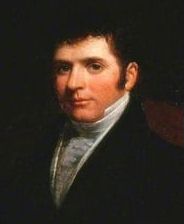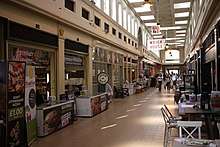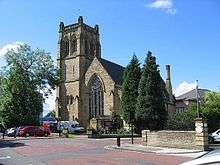John Dobson (architect)
John Dobson (1787 – 8 January 1865) was a 19th-century English architect in the neoclassical tradition. He became the most noted architect in the North of England. Churches and houses by him dot the North East - Nunnykirk Hall, Meldon Park, Mitford Hall, Lilburn Tower, St John the Baptist Church in Otterburn, Northumberland, and Beaufront Castle among them. During his career he designed more than 50 churches and 100 private houses. However, he is best known for designing Newcastle railway station and for his work with Richard Grainger developing the centre of Newcastle in a neoclassical style.

Early history
Dobson was born on 9 December 1787 in High Chirton, North Shields, in The Pineapple Inn (an earlier building on the same site) [1] He was the son of an affluent market gardener, [John Dobson, whose wife was Margaret], and young Dobson was educated in Newcastle. As a young child he had an exceptional gift for drawing. Aged 11, he executed designs for a local damask weaver. At the age of 15, he was placed as a pupil with David Stephenson, the leading architect-builder in Newcastle, designer of All Saints' Church and the original Theatre Royal that stood in Mosley Street. In 1810, aged 23, Dobson completed his studies. He then decided to go to London to study art and became a pupil of John Varley[2] the watercolourist. He was strongly encouraged by friends to stay and work in London, but by 1811 he was back in Newcastle and assisting Sir Charles Monck to design Belsay Hall. Monck was a passionate devotee of Grecian art and architecture, and it is thought that it was he who strongly influenced Dobson to adopt that style of architecture in so many of his future works. At that time, apart from Ignatius Bonomi in County Durham, he was the only practising architect between York and Edinburgh. It is not known beyond doubt what was Dobson's first building, but Dobson's daughter maintained that it was North Seaton Hall, near Ashington, built in 1813 and demolished in 1960.[3]
Dobson married Isabella, eldest daughter of Alexander Rutherford of Warburton House, Gateshead, a lady of great artistic talent, being an excellent painter of miniatures. They had three sons and five daughters. His youngest son, Alexander, inherited his father's artistic genius, gaining first prize in architecture at University College. He had just returned to his father's office full of enthusiasm to work when he was killed in the great explosion on Gateshead quayside on 4 October 1854.[4]
Country houses
Although Dobson was very versatile, and was able to build houses in Gothic or Tudor style if his clients so desired, his preferred style was Georgian. His country houses are too little known, mainly because they are not so large that they are open to the public, and are often still in private hands hidden away behind parkland and trees. The outstanding characteristics of his houses are his use of beautiful golden sandstone, Corinthian or Ionic pillared entrance porticos, elegant staircases with beautiful ironwork balustrades leading to an upper gallery with an iron balustrade of the same design, and the hall's having a domed ceiling and glass centrepiece. Often, as at Nunnykirk Hall and Longhirst Hall, the ground-floor design includes a curved or bow end at one side of the house. In all of the houses that Dobson designed, the quality of the stonework is superb, and it is believed that he used the same team of stonemasons again and again. It is also thought that this applied to other craftsmen whom he employed.[3]
Plans for Newcastle
In 1824, several years before Grainger did, Dobson put forward plans to the council for the purchase and development of Anderson Place in the centre of Newcastle. Dobson proposed a Mansion House as a 'civic palace' and grand squares linked by wide tree-lined streets. If Dobson's scheme had been accepted it would have led to a city centre even more elegant than Grainger's. However, Dobson's plan was hugely expensive and he lacked financial backing. Grainger proved to have more business acumen in putting forward his own plans for Newcastle and getting them accepted.[3]
Church of St Thomas the Martyr
In 1820 the council decided to demolish the Chapel of St Thomas the Martyr at the north end of the Tyne Bridge. To replace it the council decided to erect a new chapel at Barras Bridge on Magdalene Meadow, which belonged to St Mary Magdalene Hospital. Dobson designed the new chapel in 1827 in the modified Gothic style. Construction was completed by 1830.[5] The construction cost £6,000.[6] A novel feature is the hollow tower. Incidentally, the demolished chapel was replaced by the Watergate Building, Sandhill, also designed by John Dobson.
Central Station
.jpg)
In 1849 the High Level Bridge was built over the River Tyne, bringing the railway to Newcastle and north to Scotland. A suitably impressive station was required for a thriving town such as Newcastle, and Dobson provided it in his plans. His original plan of 1848 showed an ornate façade with a huge portico having double colonnades and an Italianate tower at the east end. Behind this was an enormous train shed made up of three arched glass roofs built in a curve on an 800-foot (240 m) radius. This design won an award at the Paris Exhibition of 1858. Unfortunately, Dobson was forced to alter his plans to produce a much less substantial portico and remove the Italianate tower. The station was completed in 1850 without the planned portico and it was not until 1863 that this was added.[7]
John Dobson argued for the role of the architect in building railway stations, and his Newcastle Central is regarded by many as the finest in England. According to Gordon Biddle and O. S. Nock in The Railway Heritage of Britain: 'Undoubtedly it would have been one of the finest 19th-century classical buildings in Europe had it been completed... Even so, Newcastle Central today is magnificent inside for its spectacular combination of curves and outside for its sheer size and length.' The train shed at Newcastle, the authors state, was the first of the great arched roofs and represented a bold step forward which was copied by others.' It was the first use of malleable rolled iron ribs – indeed the first large glass and iron vault in England, predating the Crystal Palace.
The Royal Arcade
In 1830 Richard Grainger proposed to the town council the erection of a corn exchange on a site at the bottom of Pilgrim Street, opposite Mosley Street. This plan was rejected but Grainger decided to go ahead and build a shopping arcade there instead. John Dobson produced the design based on an elegant London shopping arcade and it was completed by 1832. It was designed as two office blocks, one facing Pilgrim Street and the other facing Manor Chare. Connecting the two was a narrow block forming the arcade itself. The front façade had six fluted Corinthian columns. The interior of the arcade was 250 feet (76 m) long with an arched ceiling decorated in the Grecian style and with several domed skylights. The whole design was intended as an elegant shopping experience. The Royal Arcade was not a commercial success, as it was positioned too far away from the main shopping areas of the town centre.[7] Although demolition was considered as early as the 1880s, the arcade survived until the 1960s.[8]
Eldon Square
In 1824 Dobson was commissioned by Richard Grainger to produce designs for Eldon Square. The design was for three terraces facing a central square, each terrace being of two and a half storeys. The east and west terraces consisted of 27 bays of windows, whilst the north terrace had 39 bays. The first floors had continuous cast-iron balconies with Grecian honeysuckle decoration. Beyond this and the giant Doric pilasters at the end of each terrace there was no other decoration so that the whole effect was very simple and clean. The terraces were faced with finely cut ashlar, which was a marked improvement on the stucco used extensively in London architecture of the time.[3] Only the east terrace survives, as the other two were demolished in the 1960s to make room for Eldon Square Shopping Centre.
Grainger Market

Grainger's plans for the development of Newcastle town centre involved the demolition of the existing flesh market.[9] Grainger therefore offered to build a new meat market and vegetable market. The meat market was placed between two of the new streets, Grainger Street and Clayton Street, and the vegetable market was placed on the west side of Clayton Street. Both were designed by Dobson. The meat market had pilastered arcades, 360 windows, fanlights and wooden cornices, and four avenues each 338 feet (103 m) long. It contained 180 butchers' shops when it opened. The vegetable market was given an open-plan layout, 318 feet (97 m) long, 57 feet (17 m) wide and 40 feet (12 m) high, with a fine timber roof. In 1835, to celebrate the opening of the markets, a grand dinner was given in the vegetable market, with 2,000 guests and presided over by the Mayor. Surprisingly, in the after-dinner speeches no mention was made of Dobson.[7]
Grey Street
The crowning piece of Grainger's plan for the development of Newcastle was to be a new street leading up from Dean Street to intersect with Blackett Street. Originally called Upper Dean Street, it was eventually renamed as Grey Street.[10] Dobson was originally given the credit for the design of the whole street (by Pevsner for one), possibly due to his daughter's assertions, but it is now believed that Dobson was responsible only for the east side of the street from Shakespeare Street to Mosley Street, and that architects from Grainger's office, John Wardle and George Walker, designed the west side.[3]
Break with Grainger
In 1841 Grainger, unknown to Dobson, was in serious financial difficulties. He owed Dobson a large sum of money for work done and he tried to reduce this amount by charging Dobson £250 for a staircase and painted ceiling removed from Anderson Place. Dobson was furious at what he considered an underhand trick by Grainger and expressed his indignation in various letters that have survived. It is believed that this brought about the final breakdown of their professional relationship.[3]
Contribution to Grainger Town

The overall plan for Grainger Town was Grainger's. Grainger also exercised close control over the quality of the work. John Dobson is given much of the credit for the detailed design, but other architects made significant contributions, especially Thomas Oliver and John and Benjamin Green. In addition much work was done by two architects in Grainger's office, John Wardle and George Walker. The latter two designed the west side of Grey Street, as well as Grainger Street, Clayton Street and Market Street. Much confusion was caused by Dobson's daughter, Jane, who often claimed the credit on his behalf for work done by other architects. For instance, she claimed that Dobson designed Leazes Terrace and Leazes Crescent when in fact they were designed by Thomas Oliver.[3]
Later life
Dobson's wife, Isabella, died in 1846, aged 51. In 1859, when he was 72, he was elected first President of the newly formed Northern Architectural Association. He retired from active work in 1863 after suffering a stroke, from which he never fully recovered. He went to live for a time in Ryton. He died on 8 January 1865, aged 77, at his home in 15 New Bridge Street. He left a comfortable fortune of £16,000. The house where Dobson died still stands but subsequently became the Oxford Galleries, then a series of nightclubs.[3] It has recently (2019) been fully restored.
He is buried in Jesmond Old Cemetery where there is a memorial erected in circa 1905.[11]
List of major works with dates
- Belsay Hall (as assistant to Sir Charles Monck), Belsay (1810-1817)[12]
- The Scottish Presbyterian Church, North Shields (later a Salvation Army hall)[13]
- Newbrough Hall (1812)[14]
- North Seaton Hall near Ashington (1813) (demolished 1960)
- Prestwick Lodge (later Prestwick Hall), Ponteland (1815)
- Sandyford Park (later Nazareth House), Newcastle (1817)
- Doxford Hall near Embleton (1818)
- Morpeth Gaol and Courthouse (1822-28), the gaol was demolished in 1891 but the courthouse is still extant.[15]
- Newcastle Gaol, Carliol Square (1823), (demolished 1925)[16][17][18]
- Angerton Hall, Hartburn (1823)
- Mitford Hall, Mitford (1823-29)[19]
- Eldon Square, Newcastle (1824–26), (partially demolished 1969, nos. 1-4 remain)
- Nunnykirk Hall, near Netherwitton (1825)[20]
- Church of St Thomas the Martyr, Barras Bridge, Newcastle (1825)
- Numerous houses, villas and terraces in the New Bridge/Pandon area, Newcastle (1820s) (of these only Dobson's own house at New Bridge Street West survives)
- Lying-In Hospital, New Bridge Street, Newcastle (1826)[21]
- Scotch Church, North Bridge Street, Monkwearmouth (1827) (demolished 1891)
- St Mary's Place, Newcastle (1829)[22]
- Longhirst Hall, Morpeth (1824)[23]
- Benwell Towers, Newcastle (1831)[24]
- Royal Arcade, Newcastle (1831–32), (demolished 1969)
- Meldon Park, near Morpeth (1832)[19]
- Holme Eden Abbey, Wetheral, (1833-1837)[12]
- Grainger Market, Newcastle (1835)
- Nos. 18 - 96 (even) Grey Street, Newcastle (1836)
- Beaufront Castle, Sandhoe parish, near Hexham (1835–41)
- Newcastle General Cemetery (later Jesmond Cemetery) (1839)
- Carlton Terrace, Jesmond, Newcastle (1840)[25]
- Market Keeper's House and Office of Cattle Market, Newcastle (1842)[26]
- Lilburn Tower, near Wooler (1842)
- Church of St James, Newcastle, (1833)[27]
- Collingwood Monument (base and plinth), Tynemouth, (1845)[28]
- Royal Station Hotel, Newcastle, (1847-1850)
- Flax Mill (now the Cluny public house), Ouseburn Valley (1848)[29]
- Church of St Cuthbert, Consett, (1849-1850)
- Central railway station, Newcastle (1849–50)
- Elswick Dene, Newcastle (1850)
- Barber Surgeons Hall, Newcastle (1851)[30]
- Dobson Wing of Newcastle Infirmary, Newcastle (1852-1855) (demolished 1954)
- Warrington Museum & Art Gallery, Warrington 1855-1857[31]
- Hartlepool Cemetery, now known as Spion Kop Cemetery Local Nature Reserve (c.1856)
- Clayton Memorial Church (Jesmond Parish Church), Jesmond, Newcastle (1858)
- Church of St Edward the Confessor, Sudbrooke, Lincolnshire (1860)
- Jesmond Dene Banqueting Hall, Newcastle (1860-1862)[32]
References
- "Friends Of Jesmond Old Cemetery - Dobson". Jesmondoldcemetery.co.uk. Retrieved 2017-06-04.
- "Dobson, John : Oxford Art Online - oi". oxfordindex.oup.com. doi:10.1093/gao/9781884446054.article.t023043.
- Wilkes Lyall (1980). John Dobson, Architect and Landscape Gardener. Oriel Press Ltd. ISBN 0-85362-181-0.
- Dobson Harry (2000). Dobson on Dobson. The Pentland Press Ltd. ISBN 1-85821-813-6.
- "St Thomas The Martyr Church | History". Sttomsnewcastle.org.uk. Retrieved 2017-06-04.
- "- A detailed history of St Thomas' Church". www.sttomsnewcastle.org.uk.
- Wilkes and Dodds (1964). Tyneside Classical. John Murray.
- Morton, David (31 October 2016). "Recalling Newcastle's great 'lost' shopping centre". nechronicle.
- "Richard Grainger's vision for Grey Street, Newcastle | Tyne & Wear Archives & Museums Blog".
- Morton, David (17 March 2018). "10 Newcastle streets and who they were named after". nechronicle.
- Friends of Jesmond Old Cemetery Tomb of John Dobson. Accessed March 2011
- Good Stuff. "Belsay Hall, Belsay, Northumberland". Britishlistedbuildings.co.uk. Retrieved 2017-06-04.
- "Salvation Army Citadel (Scotch Church)". British Listed Buildings. Retrieved 4 June 2017.
- Historic England. "Newbrough Hall (1303465)". National Heritage List for England. Retrieved 30 April 2019.
- Administrator, journallive. "So would you like your day in court? - The Journal". www.thejournal.co.uk.
- Morton, David (2 April 2015). "When Newcastle had its own prison complete with executions and a treadmill!". nechronicle.
- McCorristine, Shane (20 November 2019). "Prison break - new research aims to free the history of Newcastle gaol". ncl.ac.uk. Newcastle University. Retrieved 6 August 2020.
- Kenny, David (2 April 2015). "When Newcastle had its own prison complete with executions and a treadmill!". chroniclelive.co.uk. Chronicle Live. Retrieved 6 August 2020.
- Administrator, journallive. "Country mansion to delight generations - The Journal". www.thejournal.co.uk.
- Historic England. "Details from listed building database (1041251)". National Heritage List for England. Retrieved 2 October 2015.
- Hodgson, Barbara (3 December 2016). "Discover Newcastle's "lying-in" hospital: a first outside London". nechronicle.
- http://www.blueplaqueplaces.co.uk/john-dobson-black-plaque-in-newcastle-upon-tyne-9001#.W7KJij_TVhE
- Administrator, journallive. "Hall illustrates Dobson at his best - The Journal". www.thejournal.co.uk.
- "Benwell, Benwell Lane, The Mitre PH (Benwell Towers) - sitelines.newcastle.gov.uk". www.twsitelines.info.
- Kennedy, Rob (11 August 2003). "£2m for a terraced house". nechronicle.
- Historic England. "FORMER MARKET KEEPER'S HOUSE, Newcastle upon Tyne (1355279)". National Heritage List for England. Retrieved 22 June 2020.
- England, Historic. "St James, Benwell Lane - Historic England". historicengland.org.uk.
- Sykes, Alan (16 December 2011). "The north east honours its neglected sculptor - the Durham blacksmith's son" – via www.theguardian.com.
- Chronicle, Evening (4 July 2007). "Round comes full circle". nechronicle.
- "Elswick, Houston Street, Barber-Surgeons Hall - sitelines.newcastle.gov.uk". twsitelines.info.
- Historic England. "Details from listed building database (1161270)". National Heritage List for England. Retrieved 2 October 2015.
- Historic England. "Banqueting House with added gatehouse and other extensions, Non Civil Parish (1024855)". National Heritage List for England. Retrieved 24 June 2020.
External links
| Wikimedia Commons has media related to John Dobson (architect). |